High-Performance Graphene Nanowalls/Si Self-Powered Photodetectors with HfO2 as an Interfacial Layer
Abstract
1. Introduction
2. Materials and Methods
2.1. Growth of HfO2 by Atomic Layer Deposition
2.2. Growth of GNWs
2.3. Fabrication of Photodetectors
2.4. Characterization Technique
3. Results and Discussion
4. Conclusions
Supplementary Materials
Author Contributions
Funding
Data Availability Statement
Conflicts of Interest
References
- Geim, A.K. Graphene: Status and Prospects. Science 2009, 324, 1530–1534. [Google Scholar] [CrossRef] [PubMed]
- Jia, Y.; Zhang, J.; Kong, D.; Zhang, C.; Han, D.; Han, J.; Tao, Y.; Lv, W.; Yang, Q.H. Practical Graphene Technologies for Electrochemical Energy Storage. Adv. Funct. Mater. 2022, 32, 2204272. [Google Scholar] [CrossRef]
- Irshad, H.M.; Hakeem, A.S.; Raza, K.; Baroud, T.N.; Ehsan, M.A.; Ali, S.; Tahir, M.S. Design, Development and Evaluation of Thermal Properties of Polysulphone-CNT/GNP Nanocomposites. Nanomaterials 2021, 11, 2080. [Google Scholar] [CrossRef] [PubMed]
- Plachá, D.; Jampilek, J. Graphenic Materials for Biomedical Applications. Nanomaterials 2019, 9, 1758. [Google Scholar] [CrossRef]
- Kaczmarek-Szczepańska, B.; Michalska-Sionkowska, M.; Binkowski, P.; Lukaszewicz, J.P.; Kamedulski, P. 3D-Structured and Blood-Contact-Safe Graphene Materials. Int. J. Mol. Sci. 2023, 24, 3576. [Google Scholar] [CrossRef]
- Li, X.; Zhu, H.; Wang, K.; Cao, A.; Wei, J.; Li, C.; Jia, Y.; Li, Z.; Li, X.; Wu, D. Graphene-On-Silicon Schottky Junction Solar Cells. Adv. Mater. 2010, 22, 2743–2748. [Google Scholar] [CrossRef]
- Kim, J.M.; Kim, S.; Shin, D.H.; Seo, S.W.; Lee, H.S.; Kim, J.H.; Jang, C.W.; Kang, S.S.; Choi, S.-H.; Kwak, G.Y.; et al. Si-Quantum-Dot Heterojunction Solar Cells with 16.2% Efficiency Achieved by Employing Doped-Graphene Transparent Conductive Electrodes. Nano Energy 2018, 43, 124–129. [Google Scholar] [CrossRef]
- Wang, Z.; Yu, X.; Qiu, X.; Fu, J.; Yang, D. High-Responsivity Graphene/Hyperdoped-Silicon Heterostructure Infrared Photodetectors. Opt. Laser Technol. 2022, 153, 108291. [Google Scholar] [CrossRef]
- Xia, F.; Mueller, T.; Lin, Y.-M.; Valdes-Garcia, A.; Avouris, P. Ultrafast Graphene Photodetector. Nat. Nanotechnol. 2009, 4, 839–843. [Google Scholar] [CrossRef]
- Lin, H.; Sturmberg, B.C.P.; Lin, K.-T.; Yang, Y.; Zheng, X.; Chong, T.K.; De Sterke, C.M.; Jia, B. A 90-nm-thick Graphene Metamaterial for Strong and Extremely Broadband Absorption of Unpolarized Light. Nat. Photonics 2019, 13, 270–276. [Google Scholar] [CrossRef]
- Casalino, M.; Sassi, U.; Goykhman, I.; Eiden, A.; Lidorikis, E.; Milana, S.; De Fazio, D.; Tomarchio, F.; Iodice, M.; Coppola, G.; et al. Vertically Illuminated, Resonant Cavity Enhanced, Graphene–Silicon Schottky Photodetectors. ACS Nano 2017, 11, 10955–10963. [Google Scholar] [CrossRef] [PubMed]
- Novoselov, K.S.; Geim, A.K.; Morozov, S.V.; Jiang, D.; Zhang, Y.; Dubonos, S.V.; Grigorieva, I.V.; Firsov, A.A. Electric Field Effect in Atomically Thin Carbon Films. Science 2004, 306, 666–669. [Google Scholar] [CrossRef] [PubMed]
- Bi, H.; Sun, S.; Huang, F.; Xie, X.; Jiang, M. Direct Growth of Few-Layer Graphene Films on SiO2 Substrates and Their Photovoltaic Applications. J. Mater. Chem. 2012, 22, 411–416. [Google Scholar] [CrossRef]
- Riedl, C.; Coletti, C.; Iwasaki, T.; Zakharov, A.A.; Starke, U. Quasi-Free-Standing Epitaxial Graphene on SiC Obtained by Hydrogen Intercalation. Phys. Rev. Lett. 2009, 103, 246804. [Google Scholar] [CrossRef] [PubMed]
- Rehman, M.A.; Akhtar, I.; Choi, W.; Akbar, K.; Farooq, A.; Hussain, S.; Shehzad, M.A.; Chun, S.-H.; Jung, J.; Seo, Y. Influence of an Al2O3 Interlayer in a Directly Grown Graphene-Silicon Schottky Junction Solar Cell. Carbon 2018, 132, 157–164. [Google Scholar] [CrossRef]
- Song, X.; Liu, J.; Yu, L.; Yang, J.; Fang, L.; Shi, H.; Du, C.; Wei, D. Direct Versatile PECVD Growth of Graphene Nanowalls on Multiple Substrates. Mater. Lett. 2014, 137, 25–28. [Google Scholar] [CrossRef]
- Yang, H.; Yang, J.; Bo, Z.; Zhang, S.; Yan, J.; Cen, K. Edge Effects in Vertically-Oriented Graphene Based Electric Double-Layer Capacitors. J. Power Sources 2016, 324, 309–316. [Google Scholar] [CrossRef]
- Santhosh, N.; Filipič, G.; Tatarova, E.; Baranov, O.; Kondo, H.; Sekine, M.; Hori, M.; Ostrikov, K.; Cvelbar, U. Oriented Carbon Nanostructures by Plasma Processing: Recent Advances and Future Challenges. Micromachines 2018, 9, 565. [Google Scholar] [CrossRef]
- Huang, F.; Zhang, L.; Li, S.; Fu, J.; Zhang, K.H.L.; Cheng, Q. Direct Growth of Graphene Nanowalls on Inverted Pyramid Silicon for Schottky Junction Solar Cells. ACS Appl. Energy Mater. 2021, 4, 6574–6584. [Google Scholar] [CrossRef]
- Mao, S.; Yu, K.; Chang, J.; Steeber, D.A.; Ocola, L.E.; Chen, J. Direct Growth of Vertically-oriented Graphene for Field-Effect Transistor Biosensor. Science 2013, 3, 1696. [Google Scholar] [CrossRef]
- Yu, K.; Bo, Z.; Lu, G.; Mao, S.; Cui, S.; Zhu, Y.; Chen, X.; Ruoff, R.S.; Chen, J. Growth of Carbon Nanowalls at Atmospheric Pressure for One-Step Gas Sensor Fabrication. Nanoscale Res. Lett. 2011, 6, 202. [Google Scholar] [CrossRef] [PubMed]
- Wang, J.J.; Zhu, M.Y.; Outlaw, R.A.; Zhao, X.; Manos, D.M.; Holloway, B.C.; Mammana, V.P. Free-Standing Subnanometer Graphite Sheets. Appl. Phys. Lett. 2004, 85, 1265–1267. [Google Scholar] [CrossRef]
- Nair, R.R.; Blake, P.; Grigorenko, A.N.; Novoselov, K.S.; Booth, T.J.; Stauber, T.; Peres, N.M.R.; Geim, A.K. Fine Structure Constant Defines Visual Transparency of Graphene. Science 2008, 320, 1308. [Google Scholar] [CrossRef] [PubMed]
- Nan, H.; Zhou, R.; Gu, X.; Xiao, S.; Ostrikov, K. Recent Advances in Plasma Modification of 2D Transition Metal Dichalcogenides. Nanoscale 2019, 11, 19202–19213. [Google Scholar] [CrossRef]
- Kim, H.S.; Patel, M.; Kim, J.; Jeong, M.S. Growth of Wafer-Scale Standing Layers of WS2 for Self-Biased High-Speed UV-Visible-NIR Optoelectronic Devices. ACS Appl. Mater. Interfaces 2018, 10, 3964–3974. [Google Scholar] [CrossRef]
- Patel, M.; Kim, H.S.; Kim, J. Wafer-scale Production of Vertical SnS Multilayers for High-performing Photoelectric Devices. Nanoscale 2017, 9, 15804–15812. [Google Scholar] [CrossRef]
- Mahala, P.; Patel, M.; Gupta, N.; Kim, J.; Lee, B.H. Schottky Junction Interfacial Properties at High Temperature: A Case of AgNWs Embedded Metal Oxide/p-Si. Phys. B Condens. Matter 2018, 537, 228–235. [Google Scholar] [CrossRef]
- Patel, M.; Kim, H.-S.; Park, H.-H.; Kim, J. Silver Nanowires-templated Metal Oxide for Broadband Schottky Photodetector. Appl. Phys. Lett. 2016, 108, 141904. [Google Scholar] [CrossRef]
- Lillington, D.R.; Townsend, W.G. Effects of Interfacial Oxide Layers on the Performance of Silicon Schottky-Barrier Solar Cells. Appl. Phys. Lett. 1976, 28, 97–98. [Google Scholar] [CrossRef]
- Hájková, Z.; Ledinský, M.; Vetushka, A.; Stuchlík, J.; Müller, M.; Fejfar, A.; Bouša, M.; Kalbáč, M.; Frank, O. Photovoltaic Characterization of Graphene/Silicon Schottky Junctions from Local and Macroscopic Perspectives. Chem. Phys. Lett. 2017, 676, 82–88. [Google Scholar] [CrossRef]
- Kim, J.; Kim, S.; Jeon, H.; Cho, M.H.; Chung, K.B.; Bae, C. Characteristics of HfO2 Thin Films Grown by Plasma Atomic Layer Deposition. Appl. Phys. Lett. 2005, 87, 053108. [Google Scholar] [CrossRef]
- Cuxart, M.G.; Šics, I.; Goñi, A.R.; Pach, E.; Sauthier, G.; Paradinas, M.; Foerster, M.; Aballe, L.; Fernandez, H.M.; Carlino, V.; et al. Inductively Coupled Remote Plasma-Enhanced Chemical Vapor Deposition (rPE-CVD) as a Versatile Route for the Deposition of Graphene Micro- and Nanostructures. Carbon 2017, 117, 331–342. [Google Scholar] [CrossRef]
- Wang, C.; Zhou, Y.; He, L.; Ng, T.-W.; Hong, G.; Wu, Q.-H.; Gao, F.; Lee, C.-S.; Zhang, W. In Situnitrogen-Doped Graphene Grown from Polydimethylsiloxane by Plasma Enhanced Chemical Vapor Deposition. Nanoscale 2013, 5, 600–605. [Google Scholar] [CrossRef] [PubMed]
- Zhang, N.; Li, J.; Liu, Z.; Yang, S.; Xu, A.; Chen, D.; Guo, Q.; Wang, G. Direct Synthesis of Vertical Graphene Nanowalls on Glass Substrate for Thermal Management. Mater. Res. Express. 2018, 5, 065606. [Google Scholar] [CrossRef]
- Wu, J.; Shao, Y.; Wang, B.; Ostrikov, K.K.; Feng, J.; Cheng, Q. Plasma-Produced Vertical Carbonous Nanoflakes for Li-Ion Batteries. Plasma Process. Polym. 2016, 13, 1008–1014. [Google Scholar] [CrossRef]
- Lin, G.; Wang, H.; Zhang, L.; Cheng, Q.; Gong, Z.; Ostrikov, K.K. Graphene Nanowalls Conformally Coated with Amorphous/Nanocrystalline Si as High-Performance Binder-Free Nanocomposite Anode for Lithium-Ion Batteries. J. Power Sources 2019, 437, 226909. [Google Scholar] [CrossRef]
- Ni, Z.; Wang, Y.; Yu, T.; Shen, Z. Raman Spectroscopy and Imaging of Graphene. Nano Res. 2008, 1, 273–291. [Google Scholar] [CrossRef]
- Zólyomi, V.; Koltai, J.; Kürti, J. Resonance Raman Spectroscopy of Graphite and Graphene. Phys. Status Solidi B 2011, 248, 2435–2444. [Google Scholar] [CrossRef]
- Yamada, Y.; Tasaka, S.; Inagaki, N. Surface Modification of Poly(tetrafluoroethylene) by Remote Hydrogen Plasma. Macromolecules 1996, 29, 4331–4339. [Google Scholar] [CrossRef]
- Dhanunjaya, M.; Manikanthababu, N.; Ojha, S.; Pojprapai, S.; Pathak, A.P.; Nageswara Rao, S.V.S. Effects of Growth Parameters on HfO2 Thin-films Deposited by RF Magnetron Sputtering. Radiat. Eff. Defects Solids 2022, 177, 15–26. [Google Scholar] [CrossRef]
- Hoffmann, M.; Slesazeck, S.; Mikolajick, T. Progress and Future Prospects of Negative Capacitance Electronics: A Materials Perspective. APL Mater. 2021, 9, 020902. [Google Scholar] [CrossRef]
- Alnuaimi, A.; Almansouri, I.; Saadat, I.; Nayfeh, A. High Performance Graphene-Silicon Schottky Junction Solar Cells with HfO2 Interfacial Layer Grown by Atomic Layer Deposition. Sol. Energy 2018, 164, 174–179. [Google Scholar] [CrossRef]
- Mao, J.; Yu, Y.; Wang, L.; Zhang, X.; Wang, Y.; Shao, Z.; Jie, J. Ultrafast, Broadband Photodetector Based on MoSe2/Silicon Heterojunction with Vertically Standing Layered Structure Using Graphene as Transparent Electrode. Adv. Sci. 2016, 3, 1600018. [Google Scholar] [CrossRef] [PubMed]
- Li, L.; Dong, Y.; Guo, W.; Qian, F.; Xiong, F.; Fu, Y.; Du, Z.; Xu, C.; Sun, J. High-Responsivity Photodetectors Made of Graphene Nanowalls Grown on Si. Appl. Phys. Lett. 2019, 115, 081101. [Google Scholar] [CrossRef]
- Ezhilmaran, B.; Patra, A.; Benny, S.; Bhat, S.V.; Rout, C.S. Recent Developments in the Photodetector Applications of Schottky Diodes Based on 2D Materials. J. Mater. Chem. C 2021, 9, 6122–6150. [Google Scholar] [CrossRef]
- Limmer, T.; Feldmann, J.; Da Como, E. Carrier Lifetime in Exfoliated Few-Layer Graphene Determined from Intersubband Optical Transitions. Phys. Rev. Lett. 2013, 110, 217406. [Google Scholar] [CrossRef]
- Song, Y.; Li, X.; Mackin, C.; Zhang, X.; Fang, W.; Palacios, T.; Zhu, H.; Kong, J. Role of Interfacial Oxide in High-Efficiency Graphene-Silicon Schottky Barrier Solar Cells. Nano Lett. 2015, 15, 2104–2110. [Google Scholar] [CrossRef]
- Li, X.; Zhu, M.; Du, M.; Lv, Z.; Zhang, L.; Li, Y.; Yang, Y.; Yang, T.; Li, X.; Wang, K.; et al. High Detectivity Graphene-Silicon Heterojunction Photodetector. Small 2016, 12, 595–601. [Google Scholar] [CrossRef]
- Zhang, L.; Huang, F.; Li, S.; He, S.; Yu, M.; Fu, J.; Yang, Q.; Huang, R.; Cheng, Q. Interface Engineering for Graphene Nanowalls/Silicon Schottky Solar Cells Prepared by Polymer-free Transfer Method. J. Appl. Phys. 2020, 128, 025301. [Google Scholar] [CrossRef]
- Alnuaimi, A.; Almansouri, I.; Saadat, I.; Nayfeh, A. Interface Engineering of Graphene-Silicon Schottky Junction Solar Cells with an Al2O3 Interfacial Layer Grown by Atomic Layer Deposition. RSC Adv. 2018, 8, 10593–10597. [Google Scholar] [CrossRef]
- Cong, J.; Khan, A.; Li, J.; Wang, Y.; Xu, M.; Yang, D.; Yu, X. Direct Growth of Graphene Nanowalls on Silicon Using Plasma-Enhanced Atomic Layer Deposition for High-Performance Si-Based Infrared Photodetectors. ACS Appl. Electron. Mater. 2021, 3, 5048–5058. [Google Scholar] [CrossRef]
- Shen, J.; Liu, X.; Song, X.; Li, X.; Wang, J.; Zhou, Q.; Luo, S.; Feng, W.; Wei, X.; Lu, S.; et al. High-performance Schottky Heterojunction Photodetector with Directly Grown Graphene Nanowalls as Electrodes. Nanoscale 2017, 9, 6020–6025. [Google Scholar] [CrossRef] [PubMed]
- An, X.; Liu, F.; Jung, Y.J.; Kar, S. Tunable Graphene–Silicon Heterojunctions for Ultrasensitive Photodetection. Nano Lett. 2013, 13, 909–916. [Google Scholar] [CrossRef] [PubMed]
- Sun, M.; Fang, Q.; Xie, D.; Sun, Y.; Qian, L.; Xu, J.; Xiao, P.; Teng, C.; Li, W.; Ren, T.; et al. Heterostructured Graphene Quantum Dot/WSe2/Si Photodetector with Suppressed Dark Current and Improved Detectivity. Nano Res. 2018, 11, 3233–3243. [Google Scholar] [CrossRef]
- Liu, X.; Zhou, Q.; Luo, S.; Du, H.; Cao, Z.; Peng, X.; Feng, W.; Shen, J.; Wei, D. Infrared Photodetector Based on the Photothermionic Effect of Graphene-Nanowall/Silicon Heterojunction. ACS Appl. Mater. Interfaces 2019, 11, 17663–17669. [Google Scholar] [CrossRef]
- Yang, J.; Tang, L.; Luo, W.; Feng, S.; Leng, C.; Shi, H.; Wei, X. Interface Engineering of a Silicon/Graphene Heterojunction Photodetector via a Diamond-Like Carbon Interlayer. ACS Appl. Mater. Interfaces 2021, 13, 4692–4702. [Google Scholar] [CrossRef]
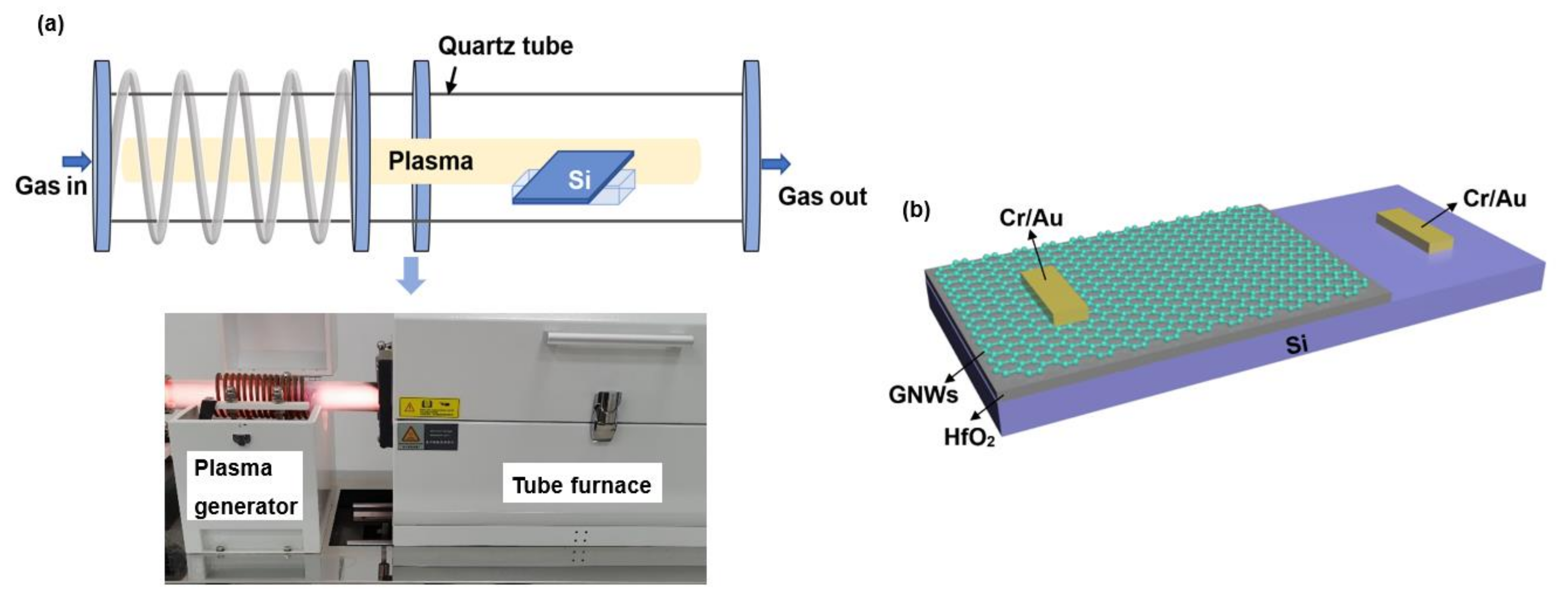

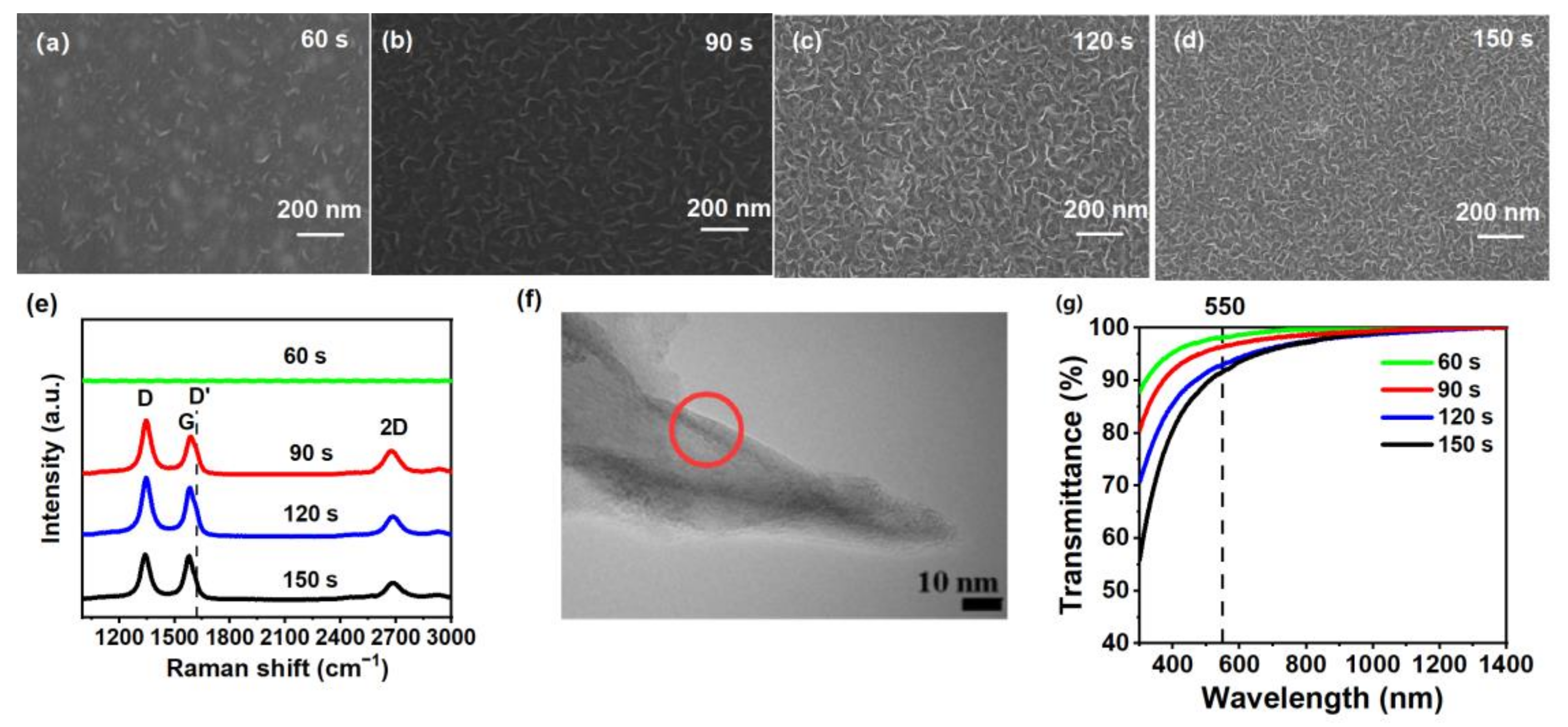
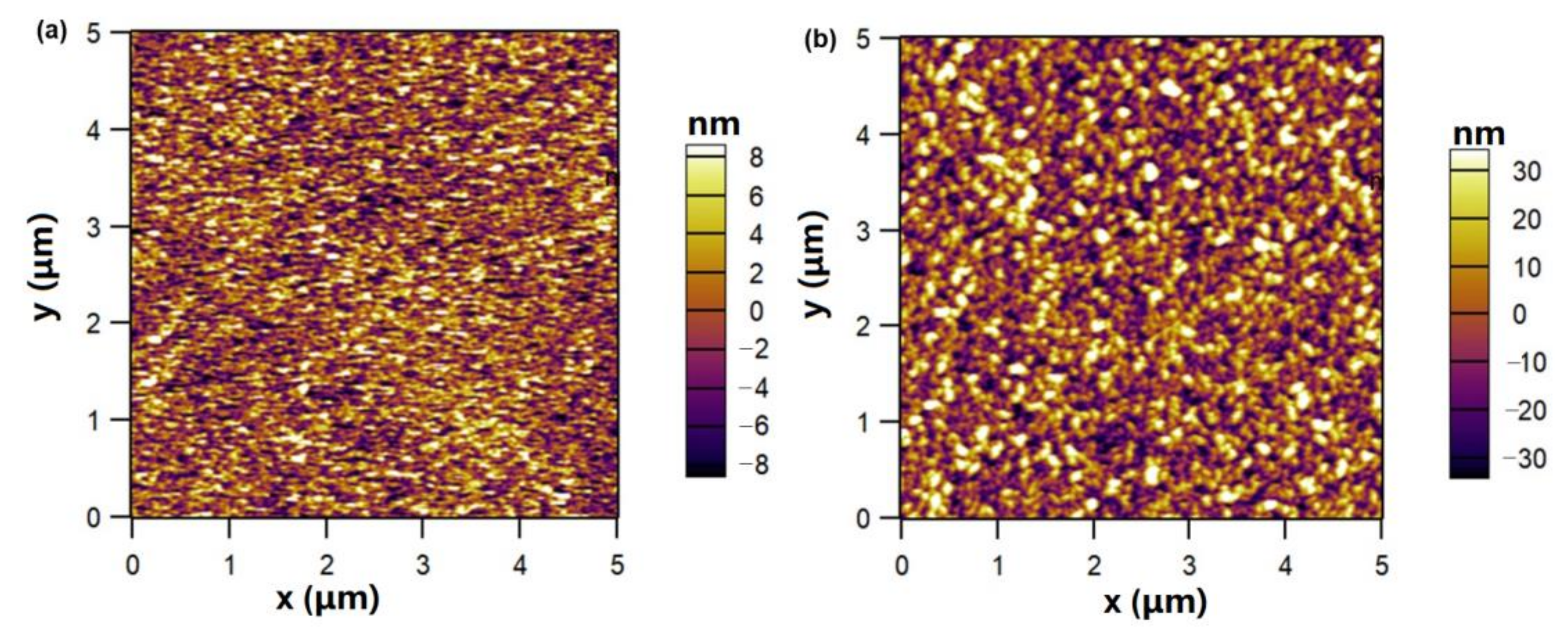
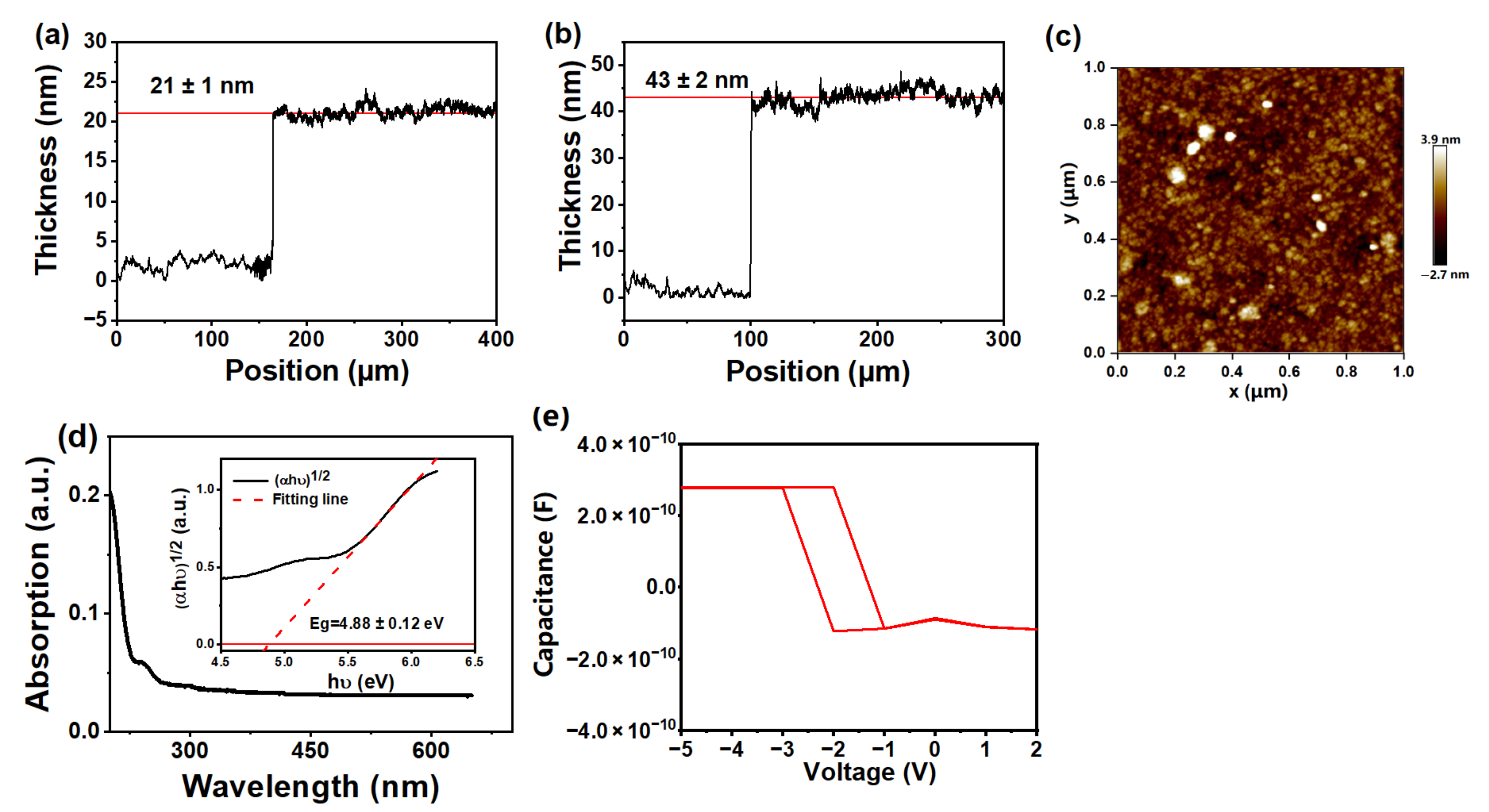
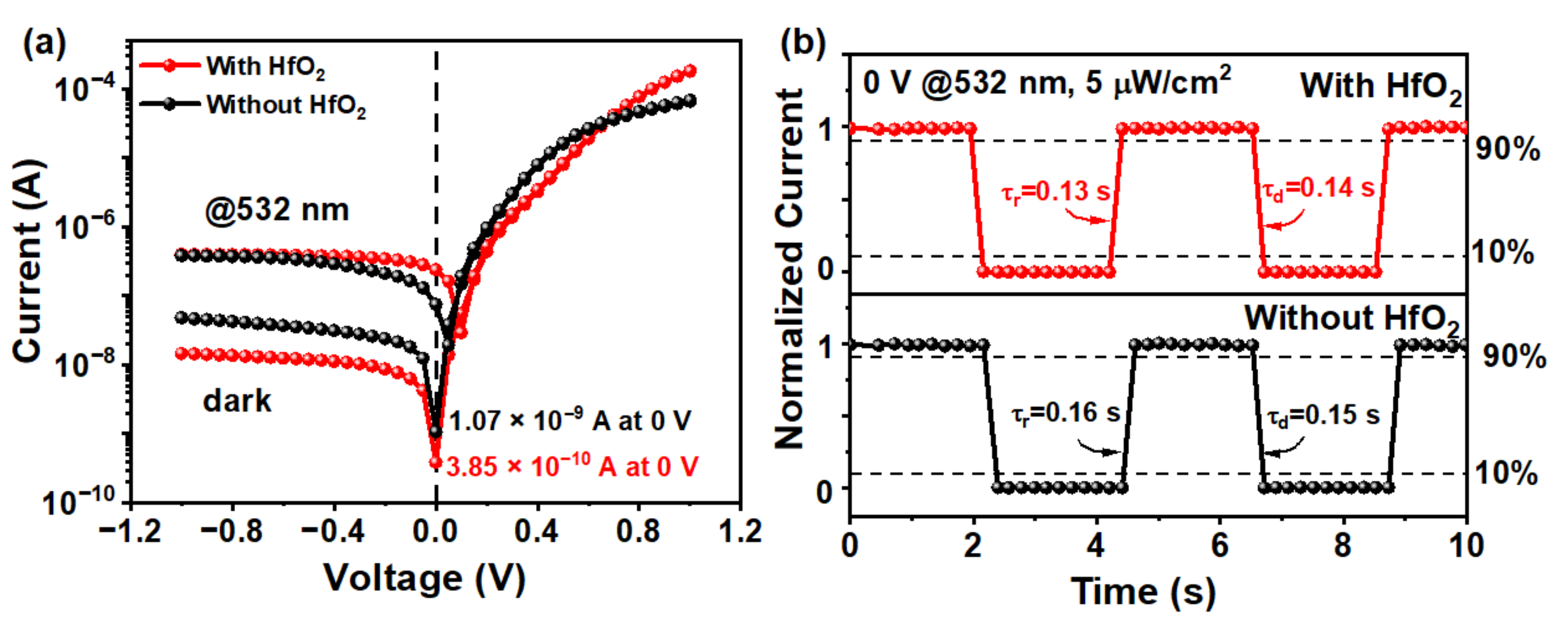

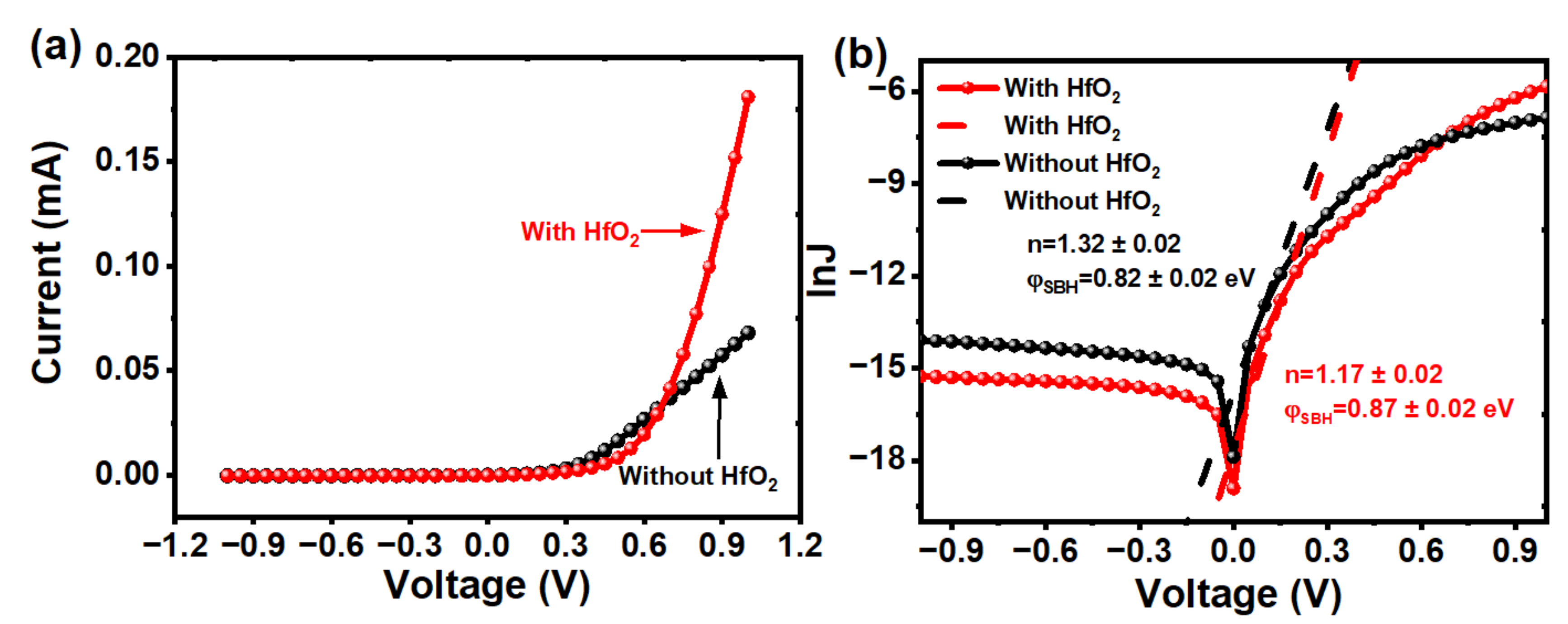
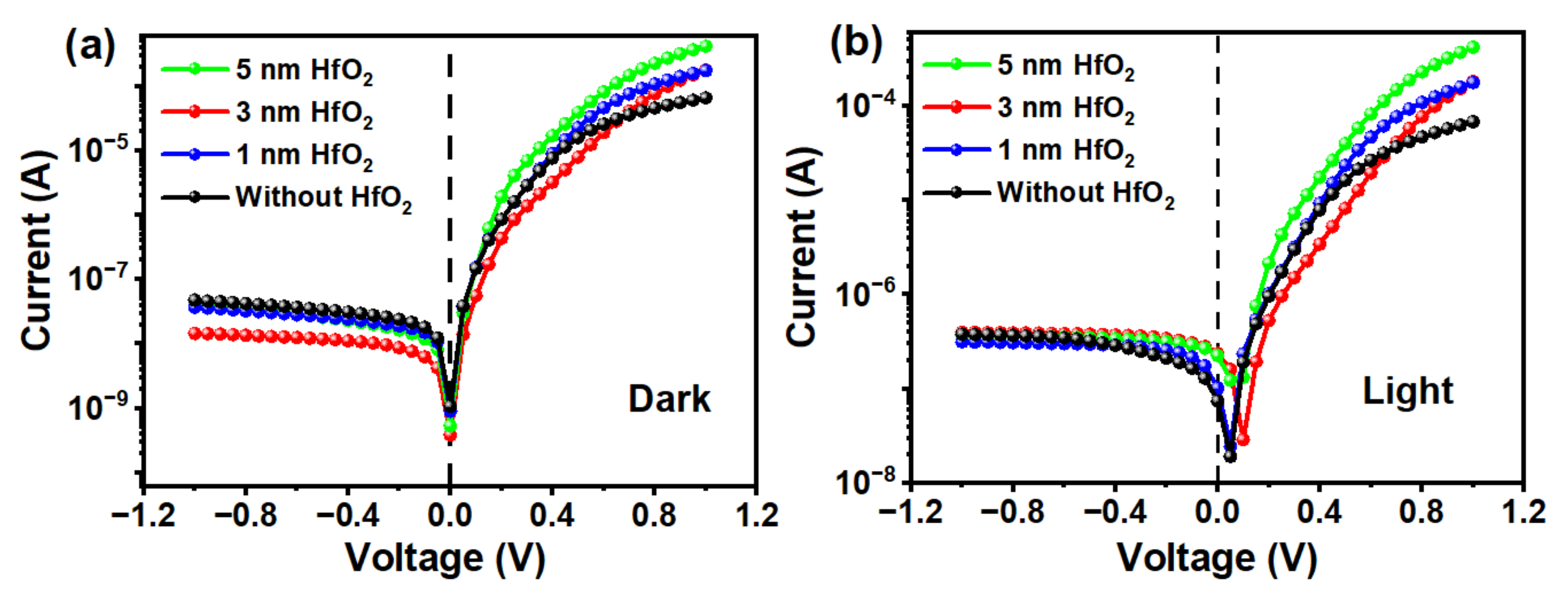
| Time (s) | Sheet Resistance (Ω/sq.) | Mobility (cm2V−1s−1) | Conductivity (Ω−1cm−1) | Carrier Concentration (cm−3) | Transmittance at 550 nm |
|---|---|---|---|---|---|
| 90 | 254.3 | 1.08 | 0.131 | 1.18 × 1016 | 96.4% |
| 120 | 211.7 | 1.77 | 0.157 | 5.55 × 1017 | 93.1% |
| 150 | 123.5 | 2.62 | 0.270 | 6.42 × 1017 | 91.5% |
| Thickness (nm) | PDCR @ 0 V | Responsivity (A/W) | Ideal Factor | Schottky Barrier Height (eV) |
|---|---|---|---|---|
| 0 | 69 | 0.058 | 1.35 ± 0.02 | 0.82 ± 0.02 |
| 1 | 113 | 0.18 | 1.24 ± 0.02 | 0.85 ± 0.02 |
| 3 | 617 | 0.19 | 1.17 ± 0.02 | 0.87 ± 0.02 |
| 5 | 425 | 0.08 | 1.33 ± 0.02 | 0.86 ± 0.02 |
| Ref. | Device Structure | Responsivity (A/W) | Response Time (τrise/τdecay) | Specific Detectivity (cm·Hz1/2/W) |
|---|---|---|---|---|
| [44] | GNWs/Si | 0.012 @0 V | - | 7.85 × 106 |
| [51] | GNWs/Si | 0.015 | 43/69 μs | 1.5 × 1011 |
| [52] | GNWs/Si | 0.52 @0 V | 40 μs | 5.88 × 1013 |
| [53] | Graphene/Si | 0.225 @−2 V | - | 7.69 × 109 |
| [54] | GQDs/WSe2/Si | 0.707 @−3 V | 0.2/0.14 ms | 4.51 × 109 |
| [55] | Graphene/Si | 1.38×10−4 @0 V | 0.37 ms | 1.6 × 109 |
| [56] | GNWs/DLC/Si | 2400 | 13/36 μs | 1.07 × 1011 |
| This work | GNWs/HfO2/n-Si | 0.19 @0 V | 0.13/0.14 s | 1.38 × 1012 |
Disclaimer/Publisher’s Note: The statements, opinions and data contained in all publications are solely those of the individual author(s) and contributor(s) and not of MDPI and/or the editor(s). MDPI and/or the editor(s) disclaim responsibility for any injury to people or property resulting from any ideas, methods, instructions or products referred to in the content. |
© 2023 by the authors. Licensee MDPI, Basel, Switzerland. This article is an open access article distributed under the terms and conditions of the Creative Commons Attribution (CC BY) license (https://creativecommons.org/licenses/by/4.0/).
Share and Cite
Shen, Y.; Li, Y.; Chen, W.; Jiang, S.; Li, C.; Cheng, Q. High-Performance Graphene Nanowalls/Si Self-Powered Photodetectors with HfO2 as an Interfacial Layer. Nanomaterials 2023, 13, 1681. https://doi.org/10.3390/nano13101681
Shen Y, Li Y, Chen W, Jiang S, Li C, Cheng Q. High-Performance Graphene Nanowalls/Si Self-Powered Photodetectors with HfO2 as an Interfacial Layer. Nanomaterials. 2023; 13(10):1681. https://doi.org/10.3390/nano13101681
Chicago/Turabian StyleShen, Yuheng, Yulin Li, Wencheng Chen, Sijie Jiang, Cheng Li, and Qijin Cheng. 2023. "High-Performance Graphene Nanowalls/Si Self-Powered Photodetectors with HfO2 as an Interfacial Layer" Nanomaterials 13, no. 10: 1681. https://doi.org/10.3390/nano13101681
APA StyleShen, Y., Li, Y., Chen, W., Jiang, S., Li, C., & Cheng, Q. (2023). High-Performance Graphene Nanowalls/Si Self-Powered Photodetectors with HfO2 as an Interfacial Layer. Nanomaterials, 13(10), 1681. https://doi.org/10.3390/nano13101681






